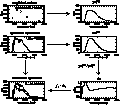We now establish a correction procedure for the library spectra
which preserves their detailed features but modifies their continua in
such a way that the synthetic colors from the corrected library
spectra conform to the empirical color-temperature relations. Since
the empirical color-temperature relations do not provide direct
access to the stellar continua, pseudo-continua are instead being
calculated for each temperature from both the empirical (Table 2 (click here))
and the theoretical (model-generated) colors. The ratio between the two
pseudo-continua then provides the desired correction function
for the given ![]() .
.

Figure 8: Black-body fit of temperature
![]() to a synthetic spectrum for
to a synthetic spectrum for
![]() , illustrating the least-squares solution of
Eqs. (3). The crosses represent the integrated
(heterochromatic) fluxes of the synthetic spectrum measured in
the different (broad) bandpasses
, illustrating the least-squares solution of
Eqs. (3). The crosses represent the integrated
(heterochromatic) fluxes of the synthetic spectrum measured in
the different (broad) bandpasses
For a given stellar flux spectrum of effective temperature ![]() ,
we define the pseudo-continua
,
we define the pseudo-continua ![]() as black
bodies of color temperature
as black
bodies of color temperature ![]() varying with wavelength:
varying with wavelength:
![]()
where ![]() is a scale factor and
is a scale factor and ![]() is the
black body function, both of which need to be determined by least-squares
fits of
is the
black body function, both of which need to be determined by least-squares
fits of ![]() to the broad-band fluxes of the
given flux spectrum. Thus,
to the broad-band fluxes of the
given flux spectrum. Thus,
![]()
where Si is the normalized transmission function of the passband
i and fi is the broad-band flux measured through this passband.
Because colors are relative measurements, we normalize by arbitrarily
setting the absolute flux in the I-band to be equal to 100:
fI=100. The black-body fit in Eq. (3) is then obtained
iteratively by a conjugate gradients method.
Figure 8 (click here) illustrates a typical result. Note that, because
effects of blanketing are ignored by this fitting procedure,
the mean temperature, ![]() , associated with the best-fitting
black-body curve, is systematically lower than the effective temperature
of the actual flux spectrum.
, associated with the best-fitting
black-body curve, is systematically lower than the effective temperature
of the actual flux spectrum.
![]() having thus been determined, the color temperatures,
having thus been determined, the color temperatures,
![]() , can be derived in a straightforward manner at the
mean wavelengths
, can be derived in a straightforward manner at the
mean wavelengths![]()
![]() of the
passbands i via the equations:
of the
passbands i via the equations:
![]()
Interpolation between the ![]() by a spline function finally
provides the continuous (and smooth) color temperatures
by a spline function finally
provides the continuous (and smooth) color temperatures ![]() (Fig. 9 (click here)) required to calculate the pseudo-continua defined
by Eq. (2).
(Fig. 9 (click here)) required to calculate the pseudo-continua defined
by Eq. (2).
The correction procedure is defined by the following sequence, and is illustrated (steps 1 to 4) in Fig. 10 (click here).
Figure 11 (click here) shows how the resulting correction functions change with decreasing effective temperature. Finally, Figs. 12 (click here) and 13 (click here) display the corresponding effective temperature sequence of original and corrected spectra at different metallicities for the full (Fig. 12 (click here)) and the visible (Fig. 13 (click here)) wavelength ranges, respectively.

Figure 9: Color temperatures for synthetic spectra covering a range of
effective temperatures, as labelled. Top pair: K-library
dwarf models; middle pair: K-library giant models; bottom
pair: ![]() -library giant models. Note that
systematically
-library giant models. Note that
systematically ![]() , as tracked down by the
black-body fit temperatures,
, as tracked down by the
black-body fit temperatures, ![]()

Figure 10: Correction procedure. All fluxes are normalized to
fI=100
The final corrected spectra are thus in a format which allows
immediate applications in population evolutionary synthesis. For a
stellar model of given mass, metallicity, and age, the radius R is
determined by calculations of its evolutionary track in the
theoretical HR diagram, and the total emergent flux at each wavelength
can hence be obtained from the present library spectra via
![]()